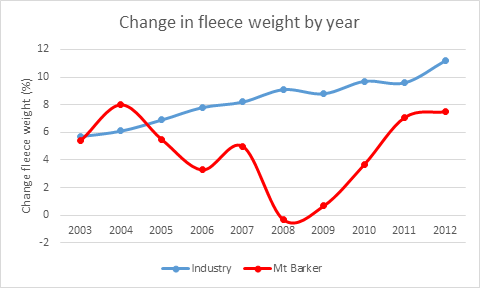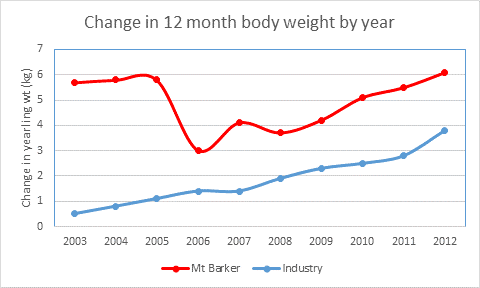What are Australian Sheep Breeding Values (ASBV)?
Genetic improvement programs aim to improve specific economically important traits in a flock through breeding. The most effective support tool to generate change is to make use of ASBV.
ASBV describe a particular sheep’s breeding value for a certain trait, for example fleece weight, body weight or fibre diameter, and express the relative breeding value of sheep across different breeding flocks of that breed.
ASBV are available for many traits such as growth rate, wool, reproduction, internal parasite (worm) resistance, dags and body conformational traits such as wrinkle and breech cover. ASBV are directly comparable across flocks within a breed.
The first step before using ASBV is to define the breeding objective — where genetic change is to be directed. This will determine the traits that are to be improved and their relative importance.
Within any group of sheep, considerable differences can be observed from one animal to the next. Some animals are larger than others, some have more wool and some have finer wool. These differences are called variation. Variation between sheep is the result of:
- the animal's individual genes
- the environment in which the animal was raised and produced.
These two sources of variation form the total variation which is called the 'phenotypic variation'. The phenotype of an animal is thus the sum of all genetic and environmental factors that impacted on a trait.
Genetic factors
Only identical twins have identical sets of genes, and all other animals have different sets of genes which impact on different traits. Animal geneticists don’t presently have a clear idea as to which genes influences which trait, but in future it will be possible to determine this. Currently technology has not advanced that far to know which genes influences which trait and by how much. Thousands of genes may be implicated for a trait and this is referred to as the genotype of an animal, and the sum effect of all the genes affecting a specific trait is measured by the ASBV value.
It is important to note that each parent passes half of their genes on to their progeny. However, the half that is passed on is not the same for different siblings. Therefore, siblings inherit different sets of genes from their parents and that is why their ASBV can be different.
As siblings will have more of their genes in common than unrelated animals, this information is used to increase the accuracy of ASBV. Some sources of information that will increase the accuracy of breeding values include:
- individual performance records
- several records on the same individual
- ancestors’ records
- half-sibling records.
Environmental factors
Different genotypes result in genetic variation between sheep, but these genetic differences can be obscured by large environmental effects such as feeding levels, management and a multitude of other environmental factors. To reduce the effect of these large environmental factors, it is important that the sheep to be compared are managed the same and in one group to ensure that all receive the same feeding and management as much as possible.
In addition, other factors that can have a major effect on an animal’s performance should also be measured. The most important factors are:
- rearing type (reared as a single or twin)
- birth date (to determine its age at measurement)
- age of its dam (older ewes lambs perform better than that of maiden ewes).
Having this information will allow corrections to be made to the different measurements to get a more accurate indication of its genotype.
Using ASBV to show how flocks change over time
ASBV are powerful tools to show how flocks change genetically over time. As an example, the below graphs show the genetic changes that have been made in the Mount Barker breech strike flock for clean fleece weight (CFW) and body weight for animals born in a particular year, against that of the industry flocks that have contributed data to sheep genetics.
The change in CFW indicates how much industry flocks have increased CFW genetically since 2003. The baseline was established in 1996 when ASBV were first published for Merino sheep. What this means is that industry sheep born in 2003 were genetically 6% better than sheep born in 1996. All the sheep born in 2011 were genetically almost 10% better than sheep born in 1996 and thus 4% better than sheep born in 2006.
The Mount Barker breech strike flock was established in 2006 and shows that CFW actually declined until 2008. This was caused by selecting sheep that had extremely bare breeches and that had very low skin wrinkle. It’s well known that such sheep cut less wool and this resulted in this decline in CFW up to 2008. However, from 2008 there was a strong increase in CFW which implies that the flock has dramatically improved genetically and that the 2011 born lambs only lag about 3% behind industry flocks.
The results are similar for body weight. The below graph shows genetic changes in yearling body weight from 2003-2012 for the breech strike flock against industry Merino flocks. The breech strike flock was initially about 4 kilograms (kg) heavier than industry flocks but a sharp reduction took place until 2006. This was mostly due to selecting extremely bare breech sheep that had very low skin wrinkle while ignoring body weight in the selection process. Since 2006 the flock genetically became heavier due to the implementation of an efficient selection program. The fine-medium wool industry sheep flocks were on average 1-2kg lighter than the breech strike flocks but also showed a steady increase in body weight over time.
These trends allow breeders to see changes that have occurred over time in their flock and how they perform relative to industry flocks. ASBV also make it possible for breeders to identify genetically superior industry flocks that can be sourced to increase genetic gain in their own flocks for their specific breeding objective.
For more information on using ASBV refer to Sheep Genetics Australia, LambPlan and MerinoSelect.


